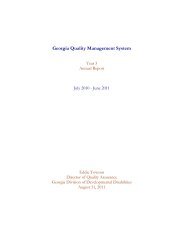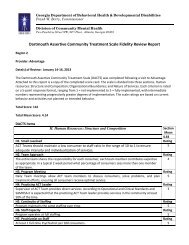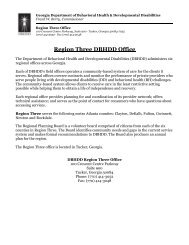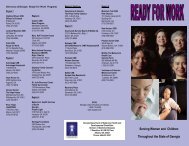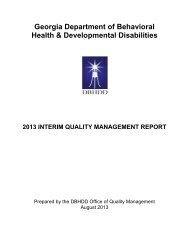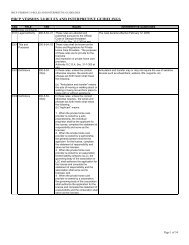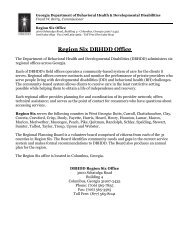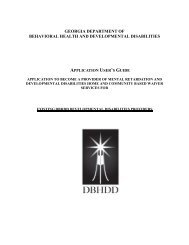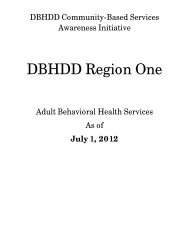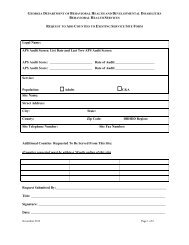. Primary pediatric care, including immunization, for their children;c. Gender specific substance abuse treatment <strong>and</strong> other therapeutic interventions for women, whichmay address issues <strong>of</strong> relationships, sexual <strong>and</strong> physical abuse, parenting, <strong>and</strong> child care;d. Therapeutic interventions for children in custody <strong>of</strong> women in treatment which may addressdevelopmental needs, sexual <strong>and</strong> physical abuse <strong>and</strong> neglect; <strong>and</strong>e. Sufficient case management <strong>and</strong> transportation to ensure access to services. SAPTBG8. Providers that receive SAPTBG funds provide IV Drug Users access to a treatment program not later than:a. Fourteen days after making the request for admission to a program; orb. One hundred <strong>and</strong> twenty days after the date <strong>of</strong> such request, if:i. No such program has the capacity to admit the individual on the date <strong>of</strong> such request, <strong>and</strong>ii. Interim services, including referral for prenatal care, are made available to the individualnot later than 48 hours after such request. SAPTBGiii. Wellness <strong>of</strong> individuals is facilitated through:1. Advocacy;2. Individual service/treatment practices;3. Education;4. Sensitivity to issues affecting wellness including but not limited to:a. Gender;b. Culture; <strong>and</strong>c. Age.5. Incorporation <strong>of</strong> wellness goals within the individual plan.iv. Sensitivity to individual’s differences <strong>and</strong> preferences is evident.v. Practices <strong>and</strong> activities that reduce stigma are implemented.vi. If services include provision in non-clinic settings, providers must have the ability to deliver services in variousenvironments, such as homes, schools, homeless shelters, or street locations. Individuals/families may prefer to meetstaff at community locations other than their homes or other conspicuous locations (e.g. their school, employer).1. The organization must have policies that govern the provision <strong>of</strong> services in natural settings <strong>and</strong> c<strong>and</strong>ocument that it respects youth <strong>and</strong>/or families’ right to privacy <strong>and</strong> confidentiality2. Staff should be sensitive to <strong>and</strong> respectful <strong>of</strong> the individual's privacy/confidentiality rights <strong>and</strong> preferences tothe greatest extent possible (e.g. if staff must meet with an individual during their school/work time,choosing inconspicuous times <strong>and</strong> locations to promote privacy), especially if staff drive a vehicle that isclearly marked as a state or agency vehicle, or if staff must identify themselves <strong>and</strong> their purpose toengage with the consumer in a way that may potentially embarrass the individual or breech the individual’sprivacy/confidentiality.vii. Interactions with individuals demonstrate respect, careful listening, <strong>and</strong> are positive <strong>and</strong> supportive.2. Required Business Practices <strong>and</strong> Policiesa. Program requirements, compliance, <strong>and</strong> structurei. Applicable statutory requirements, rules, regulations, licensing, accreditation, <strong>and</strong> contractual/agreementrequirements are evident in organizational policies, procedures <strong>and</strong> practices. In the event that the aboverequirements <strong>and</strong> st<strong>and</strong>ards are more stringent than these St<strong>and</strong>ards, providers shall defer to those requirementswhich are most stringent.1. Providers receiving MHBG funds must comply with Public Law 102-321, Section 1912 <strong>and</strong> applicable codesections at www.mentalhealth.samhsa.gov. MHBG2. Providers receiving SATBG funds must comply with 45 CFR 96 Rules <strong>and</strong> Regulations atwww.samhsa.gov/centers/csat/csat.html. SAPTBGii. The provider shall adhere to supplementary requirements as published by the <strong>Department</strong> <strong>of</strong> Community <strong>Health</strong><strong>and</strong> the External Review Organization (e.g. MICP User Guide, Encounter User Guide).iii. The provider clearly describes available services, supports, <strong>and</strong> treatment1. The provider has a description <strong>of</strong> its services, supports, <strong>and</strong> treatment that includes a description <strong>of</strong>:a. The population served;b. How the provider plans to strategically address the needs <strong>of</strong> those served; <strong>and</strong>c. Services available to potential <strong>and</strong> current individuals.2. The provider has internal structures that support good business practices.a. There are clearly stated current policies <strong>and</strong> procedures for all aspects <strong>of</strong> the operation <strong>of</strong> theorganization;b. Policies <strong>and</strong> corresponding procedures direct the practice <strong>of</strong> the organization; <strong>and</strong>c. Staff is trained in organization policies <strong>and</strong> procedures.FY2013 Provider Manual for Community <strong>Behavioral</strong> <strong>Health</strong> Providers
3. The provider details the desired expectation <strong>of</strong> the services, supports, <strong>and</strong> treatment <strong>of</strong>fered <strong>and</strong> theoutcomes for each <strong>of</strong> these services.4. The level <strong>and</strong> intensity <strong>of</strong> services, supports, <strong>and</strong> treatment <strong>of</strong>fered is:a. Within the scope <strong>of</strong> the organization;b. According to benchmarked practices; <strong>and</strong>c. Timely as required by individual need.5. The provider has administrative <strong>and</strong> clinical structures that are clear <strong>and</strong> that support individual services.a. Administrative <strong>and</strong> clinical structures promote unambiguous relationships <strong>and</strong> responsibilities.6. The program description identifies staff to individual served ratios for each service <strong>of</strong>fered:a. Ratios reflect the needs <strong>of</strong> consumers served, implementation <strong>of</strong> behavioral procedures, bestpractice guidelines <strong>and</strong> safety considerations.7. Policies, procedures <strong>and</strong> practice describe processes for referral <strong>of</strong> the individual based on ongoingassessment <strong>of</strong> individual need:a. Internally to different programs or staff; orb. Externally to services, supports, <strong>and</strong> treatment not available within the organization including, butnot limited to healthcare for:i. Routine assessment such as annual physical examinations;ii. Chronic medical issues (Specific to AD providers, if tuberculosis or HIV are identifiedmedical issues, services such as diagnostic testing, counseling, etc. must be madeavailable within the provider or through referrals to other appropriate entities [althoughthese services are not required as a condition <strong>of</strong> receiving treatment services forsubstance abuse, <strong>and</strong> are undertaken voluntarily <strong>and</strong> with the informed consent <strong>of</strong> theindividual SAPTBG );iii. Ongoing psychiatric issues;iv. Acute <strong>and</strong> emergent medical <strong>and</strong>/or psychiatric needs;v. Diagnostic testing such as psychological testing or labs; <strong>and</strong>vi. Dental services.c. In the event that the SAPTBG provider has insufficient capacity to serve any pregnant womanseeking AD treatment, the provider will refer the woman to the Regional Office. SAPTBGd. In the event that the SAPTBG provider has insufficient capacity to serve any IV Drug user seekingAD treatment, the provider shall establish a system for reporting unmet dem<strong>and</strong> to the RegionalOffice.i. The provider, upon reaching 90 percent <strong>of</strong> service capacity, must notify the RegionalOffice within seven days.ii. A waiting list shall use a unique patient identifier for each injecting drug abuser seekingtreatment, including those receiving interim services while awaiting admission to suchtreatment. The reporting system shall ensure that individuals who cannot be placed incomprehensive treatment within 14 days receive ongoing contact <strong>and</strong> appropriate interimservices while awaiting admission. SAPTBGb. Subcontractingi. As permitted by provider agreement/contract, the provider that contracts with other organizations/practitionersensures the affiliates’ compliance <strong>and</strong> capacity to provide services to include compliance with:1. Contract/Agreement requirements;2. St<strong>and</strong>ards herein;3. Licensure requirements;4. Accreditation requirements; <strong>and</strong>5. Quality improvement <strong>and</strong> risk reduction activities.ii. The affiliate’s capacity to provide quality services is monitored, including:1. Financial oversight <strong>and</strong> management <strong>of</strong> individual funds;2. Staff competency <strong>and</strong> training;3. Mechanisms that assure service is provided according to the individual’s IRP; <strong>and</strong>4. There is evidence <strong>of</strong> active oversight <strong>of</strong> the affiliate’s capacity <strong>and</strong> compliance.iii. A report shall be made quarterly to the provider’s Board <strong>of</strong> Directors regarding services delivered <strong>and</strong> quality <strong>of</strong>performance by affiliate;iv. A report shall be made to the DBHDD Regional Office prior to the end <strong>of</strong> the first quarter <strong>and</strong> third quarter <strong>of</strong> thefiscal year that includes:1. Name <strong>of</strong> the affiliate or contractor;FY2013 Provider Manual for Community <strong>Behavioral</strong> <strong>Health</strong> Providers
- Page 1 and 2:
Georgia Department of Behavioral He
- Page 3 and 4:
UPDATED FOR JULY 1, 2013SUMMARY OF
- Page 5 and 6:
C&A Core ServicesBehavioral Health
- Page 7 and 8:
Community Supportsupports;9) Assist
- Page 9 and 10:
Community SupportServiceAccessibili
- Page 11 and 12:
Community Transition Planningv. App
- Page 13 and 14:
Diagnostic AssessmentTransactionCod
- Page 15 and 16:
Family Outpatient Services: Family
- Page 17 and 18:
Family Outpatient Services: Family
- Page 19 and 20:
Family Outpatient Services: Family
- Page 21 and 22:
Group Outpatient Services: Group Co
- Page 23 and 24:
Group Outpatient Services: Group Tr
- Page 25 and 26:
Individual CounselingServiceDefinit
- Page 27 and 28:
Medication AdministrationAdmissionC
- Page 29 and 30:
Nursing Assessment and Health Servi
- Page 31 and 32:
Continuing StayCriteriaDischargeCri
- Page 33 and 34:
Psychiatric TreatmentAdditionalMedi
- Page 35 and 36:
Service Plan DevelopmentPractitione
- Page 37 and 38:
CHILD & ADOLESCENT SPECIALTY SERVIC
- Page 39 and 40:
Behavioral AssistanceAssistance.Ser
- Page 41 and 42:
Crisis Stabilization Unit (CSU) Ser
- Page 43 and 44:
Crisis Stabilization Unit (CSU) Ser
- Page 45 and 46:
Intensive Family Intervention5. Bec
- Page 47 and 48:
Intensive Family Interventionconfid
- Page 49 and 50:
Intensive Family Intervention10. Th
- Page 51 and 52:
Structured Activity SupportsService
- Page 53 and 54:
Structured Residential SupportsClin
- Page 55 and 56:
Substance Abuse Intensive Outpatien
- Page 57 and 58:
Substance Abuse Intensive Outpatien
- Page 59 and 60:
Substance Abuse Intensive Outpatien
- Page 61 and 62:
RequiredComponents1. Any diagnosis
- Page 63 and 64:
Community Support3. Contact must be
- Page 65 and 66:
Community Transition Planning3. Jai
- Page 67 and 68:
ContinuingStay CriteriaDischargeCri
- Page 69 and 70:
Family Outpatient Services: Family
- Page 71 and 72:
Family Outpatient Services: Family
- Page 73 and 74:
Family Outpatient Services: Family
- Page 75 and 76:
Group Outpatient Services: Group Co
- Page 77 and 78:
Group Outpatient Services: Group Tr
- Page 79 and 80:
Individual CounselingServiceDefinit
- Page 81 and 82:
StaffingRequirementsServiceAccessib
- Page 83 and 84:
Medication Administrationliving.Req
- Page 85 and 86:
Nursing Assessment and Health Servi
- Page 87 and 88:
Psychiatric Treatmentbehaviormodify
- Page 89 and 90:
Psychological Testing: Psychologica
- Page 91 and 92:
Service Plan DevelopmentRecovery pl
- Page 93 and 94: Ambulatory Substance Abuse Detoxifi
- Page 95 and 96: Assertive Community Treatmente. Ass
- Page 97 and 98: Assertive Community Treatment• Di
- Page 99 and 100: Assertive Community Treatment• di
- Page 101 and 102: Assertive Community Treatment11. Fo
- Page 103 and 104: Assertive Community Treatmentin whi
- Page 105 and 106: Consumer/Family AssistanceTransacti
- Page 107 and 108: Consumer/Family Assistancecriticaln
- Page 109 and 110: Crisis Stabilization Unit Servicesb
- Page 111 and 112: ClinicalExclusionsDocumentationRequ
- Page 113 and 114: Peer Support Services4. Individual
- Page 115 and 116: Peer Support ServicesClinicalOperat
- Page 117 and 118: Psychosocial RehabilitationUnit Val
- Page 119 and 120: Psychosocial Rehabilitationmust dem
- Page 121 and 122: Psychosocial RehabilitationBilling
- Page 123 and 124: Residential: Independent Residentia
- Page 125 and 126: Residential: Intensive Residential
- Page 127 and 128: Residential: Semi-Independent Resid
- Page 129 and 130: Residential Substance Detoxificatio
- Page 131 and 132: ServiceDefinitionAdmissionCriteriaC
- Page 133 and 134: AdmissionCriteria,continuedContinui
- Page 135 and 136: 1. It is expected that the transiti
- Page 137 and 138: DocumentationRequirements1. Every a
- Page 139 and 140: FY2013 Provider Manual for Communit
- Page 141 and 142: TABLE B: Physicians, Physician’s
- Page 143: COMMUNITY SERVICE STANDARDS FOR ALL
- Page 147 and 148: 7. The provider’s practice of cul
- Page 149 and 150: c. Is not permitted in developmenta
- Page 151 and 152: 2. Policies, procedures, and guidel
- Page 153 and 154: 3. Safe transport of persons served
- Page 155 and 156: iv. There are safeguards utilized f
- Page 157 and 158: i. The date and time the medication
- Page 159 and 160: Training Requirements for all Staff
- Page 161 and 162: Qualified MedicationAide (QMA)Psych
- Page 163 and 164: Addiction CounselorTrainees (ACT)Hi
- Page 165 and 166: CADC, CCADC, CAC II or MAC and is r
- Page 167 and 168: practitioner), s/he could bill as a
- Page 169 and 170: COMMUNITY SERVICE STANDARDS FOR ALL
- Page 171 and 172: 4. ORDER/RECOMMENDATION FOR COURSE
- Page 173 and 174: ii. Services, supports, and treatme
- Page 175 and 176: xv.xvi.xvii.Recorded changes - Any



